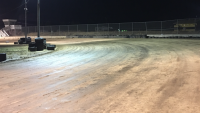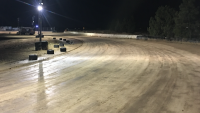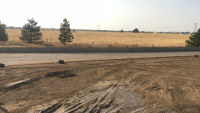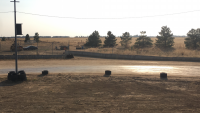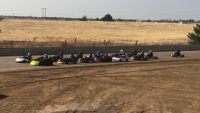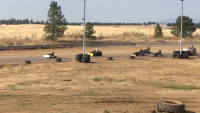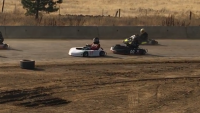You are using an out of date browser. It may not display this or other websites correctly.
You should upgrade or use an alternative browser.
You should upgrade or use an alternative browser.
Video of track prepping
- Thread starter bullerman
- Start date
racing promotor
Moderator
Nothing I've ever seen or heard about, did you have a certain question ?
Ted Hamilton
Helmet Painter / Racer
Not a video, but a good article: https://www.onedirt.com/tech/an-inside-look-at-preparing-a-dirt-track-for-race-night/
Ted Hamilton
Helmet Painter / Racer
Ted Hamilton
Helmet Painter / Racer
Even better:
Ted Hamilton
Helmet Painter / Racer
racing promotor
Moderator
Totally Unnecessary to race karts once the track is firm and smooth, It all get's done within the top 1/2" max.
Ted Hamilton
Helmet Painter / Racer
I figured that since karts were lighter, less impact and tear-up of surface....even treads on karts don't seem to cause issues. (despite common misconceptions otherwise!!)
racing promotor
Moderator
Did it 17 seasons never disc more than 4 times per season and in those 17 seasons only twice was it 6 to 8 inches deep.
I know of several tracks in our area that require different methods. Some need the soil mixed to get sand mixed back in, another has silt which needs remixed with the clay and some never have to do more than drag the high spots off. I think it depends mostly on the soil content in an area, simply poking holes with an aerator will get moisture down in. Ive helped with track prep for several years.
Ted Hamilton
Helmet Painter / Racer
A mini sheepsfoot would be nice....about quarter sized...
racing promotor
Moderator
Depending on how hard it is, and how much clay you don't even need a 1/2" deep.
racinnut15xm
Member
yeah all those videos posted are big car tracks, I don't see kart place more than dragging with a box blade once you get it packed in. Back stretch at our local place gets some bad ripples in it when it rains hard.Totally Unnecessary to race karts once the track is firm and smooth, It all get's done within the top 1/2" max.
Although I’m far from a master of this phenomenon, as I sit on a mountain of mistakes it’s taken me to learn thus far. A few things come to mind. I operate a 1/5 mile clay oval in eastern Washington. We are a kart track, no sprints or big cars or bikes or quads. Medium to semi high bite track. I’ve only been at this 3 years so I am still very green in all of this. I keep a very detailed log that records temperature, humidity, wind, cloud cover, amount of water, additives or not, etc. My log has helped me to refine the system I use and at what time of the year I use whichever method is suited to the seasonal climate. I have, in the past used calcium chloride, magnesium chloride, VP Stay-Wet, TrackMoist, and other additives. It is my opinion that in my situation I’m throwin good money away and that there is no replacement for water placement. A good, solid base is a must. A couple inches of loose material on top is what I find to work best for our location. For me to explain every step and the road that has lead me to the methods I use would require me to write a small novel. I’ll save all y’all the time and condense it as best I can. I do not use a road grader. I have a 4000 gallon capacity water truck that I pull a 1000lb drag around to cut any highs and fill lows. The infield has a surplus of material that I pull onto the track as I’m dragging if I need. Once I’ve drug the track smooth, and have a couple inches of loose, fine material I break out my roller. It’s your normal run of the mill 30k lb roller you’d see on a road construction project. This smashes the bigger rocks n such into the surface and gives a little density to the fluff. This next step is where my log comes in to play. Depending on which season it is, determined when, and how much water I put on. I use the water truck, as well as 2” fire hose to really lay it in heavy when needed. Hose watering is more labor intensive, although you cannot get the amount of water in the track with the truck without tearing the hell outta the surface. We have great lighting at our track, so I water only at night. I let the track come dry between watering. When it’s time to bring the track in, I focus on timing, when there is still moisture present on the surface, is tacky somewhat but barely sticks to my rubber Muck boots, I hit it with the roller. Starting around the top of the track working to the bottom, then back to the top. The rolling process takes about 2-3 hours, depending on conditions. Sometimes, a little spritz if water is needed by the time I’m passing the bottom the first time over. The last step is to wheel pack the surface with a vehicle. I use my 2003 Mustang and it works very well. This is what works for me in my location. It’ll be different for everywhere else. So many variables. In closing, I like to use the cheapest laundry detergent I can find as my water additive. I buy the cheap white powder stuff from the dollar store. 4 boxes per 4000 gallons.
Attachments
Last edited by a moderator:
I’m able to run night, or day, two shows per day if needed. Minimal if any dust. Maybe a quick trip around with the truck at intermission if needed. The track doesn’t chunk up and has multiple racing grooves.
Attachments
XXX#40
2A supporter
Sam's club or Costco or even a janitorial supply company and get white dish washing liquidAlthough I’m far from a master of this phenomenon, as I sit on a mountain of mistakes it’s taken me to learn thus far. A few things come to mind. I operate a 1/5 mile clay oval in eastern Washington. We are a kart track, no sprints or big cars or bikes or quads. Medium to semi high bite track. I’ve only been at this 3 years so I am still very green in all of this. I keep a very detailed log that records temperature, humidity, wind, cloud cover, amount of water, additives or not, etc. My log has helped me to refine the system I use and at what time of the year I use whichever method is suited to the seasonal climate. I have, in the past used calcium chloride, magnesium chloride, VP Stay-Wet, TrackMoist, and other additives. It is my opinion that in my situation I’m throwin good money away and that there is no replacement for water placement. A good, solid base is a must. A couple inches of loose material on top is what I find to work best for our location. For me to explain every step and the road that has lead me to the methods I use would require me to write a small novel. I’ll save all y’all the time and condense it as best I can. I do not use a road grader. I have a 4000 gallon capacity water truck that I pull a 1000lb drag around to cut any highs and fill lows. The infield has a surplus of material that I pull onto the track as I’m dragging if I need. Once I’ve drug the track smooth, and have a couple inches of loose, fine material I break out my roller. It’s your normal run of the mill 30k lb roller you’d see on a road construction project. This smashes the bigger rocks n such into the surface and gives a little density to the fluff. This next step is where my log comes in to play. Depending on which season it is, determined when, and how much water I put on. I use the water truck, as well as 2” fire hose to really lay it in heavy when needed. Hose watering is more labor intensive, although you cannot get the amount of water in the track with the truck without tearing the hell outta the surface. We have great lighting at our track, so I water only at night. I let the track come dry between watering. When it’s time to bring the track in, I fo is on timing, when there is still moisture present on the surface, is tacky somewhat but barely sticks to my rubber Muck boots, I hit it with the roller. Starting around the top of the track working to the bottom, then back to the top. The rolling process takes about 2-3 hours, depending on conditions. Sometimes, a little spritz if water is needed by the time I’m passing the bottom the first time over. The last step is to wheel pack the surface with a vehicle. I use my 2003 Mustang and it works very well. This is what works for me in my location. It’ll be different for everywhere else. So many variables. In closing, I like to use the cheapest laundry detergent I can find as my water additive. I buy the cheap white powder stuff from the dollar store. 4 boxes per 4000 gallons.
racing promotor
Moderator
Keep the big steel drum roller off of it and it will not slick over as much and will take water better, you don't need moisture deep just need enoughtop 3/8" or so.Although I’m far from a master of this phenomenon, as I sit on a mountain of mistakes it’s taken me to learn thus far. A few things come to mind. I operate a 1/5 mile clay oval in eastern Washington. We are a kart track, no sprints or big cars or bikes or quads. Medium to semi high bite track. I’ve only been at this 3 years so I am still very green in all of this. I keep a very detailed log that records temperature, humidity, wind, cloud cover, amount of water, additives or not, etc. My log has helped me to refine the system I use and at what time of the year I use whichever method is suited to the seasonal climate. I have, in the past used calcium chloride, magnesium chloride, VP Stay-Wet, TrackMoist, and other additives. It is my opinion that in my situation I’m throwin good money away and that there is no replacement for water placement. A good, solid base is a must. A couple inches of loose material on top is what I find to work best for our location. For me to explain every step and the road that has lead me to the methods I use would require me to write a small novel. I’ll save all y’all the time and condense it as best I can. I do not use a road grader. I have a 4000 gallon capacity water truck that I pull a 1000lb drag around to cut any highs and fill lows. The infield has a surplus of material that I pull onto the track as I’m dragging if I need. Once I’ve drug the track smooth, and have a couple inches of loose, fine material I break out my roller. It’s your normal run of the mill 30k lb roller you’d see on a road construction project. This smashes the bigger rocks n such into the surface and gives a little density to the fluff. This next step is where my log comes in to play. Depending on which season it is, determined when, and how much water I put on. I use the water truck, as well as 2” fire hose to really lay it in heavy when needed. Hose watering is more labor intensive, although you cannot get the amount of water in the track with the truck without tearing the hell outta the surface. We have great lighting at our track, so I water only at night. I let the track come dry between watering. When it’s time to bring the track in, I fo is on timing, when there is still moisture present on the surface, is tacky somewhat but barely sticks to my rubber Muck boots, I hit it with the roller. Starting around the top of the track working to the bottom, then back to the top. The rolling process takes about 2-3 hours, depending on conditions. Sometimes, a little spritz if water is needed by the time I’m passing the bottom the first time over. The last step is to wheel pack the surface with a vehicle. I use my 2003 Mustang and it works very well. This is what works for me in my location. It’ll be different for everywhere else. So many variables. In closing, I like to use the cheapest laundry detergent I can find as my water additive. I buy the cheap white powder stuff from the dollar store. 4 boxes per 4000 gallons.
twostroketoowoke
Member
Do yourself a solid and listen to the zero analytics podcast with Mackie Flood. Worth the listen

